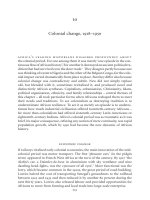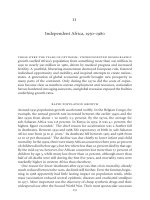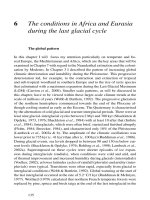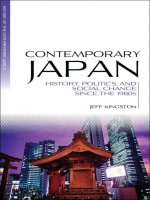Independent Africa, 1950–1980
Bạn đang xem bản rút gọn của tài liệu. Xem và tải ngay bản đầy đủ của tài liệu tại đây (4.01 MB, 22 trang )
P1: RNK
0521864381c11 CUNY780B-African 978 0 521 68297 8 May 15, 2007 16:29
11
Independent Africa, 1950–1980
these were the years of optimism. unprecedented demographic
growth swelled Africa’s population from something more than 200 million in
1950 to nearly 500 million in 1980,drivenbymedical progress and increased
fertility. A youthful, liberating momentum destroyed European rule, fostered
individual opportunity and mobility, and inspired attempts to create nation-
states. A generation of global economic growth brought new prosperity to
many parts of the continent. Only during the 1970s did the costs of expan-
sion become clear as numbers outran employment and resources, nationalist
heroes hardened into aging autocrats, and global recession exposed the frailties
underlying growth rates.
rapid population growth
Around 1950 population growth accelerated swiftly. In the Belgian Congo, for
example, the annual growth rate increased between the earlier 1940s and the
late 1950sfromabout1 to nearly 2.5 percent. By the 1970s, the average for
sub-Saharan Africa was 2.8 percent. In Kenya in 1979,itwas 4.1 percent, the
highest figure recorded.
1
The chief reason for acceleration was a further fall
in deathrates. Between 1950 and 1988, life expectancy at birth in sub-Saharan
Africa rose from 39 to 51 years.
2
Itsdeathrate fell between 1965 and 1988 from
22 to 16 per thousand.
3
The decline was due chiefly to lower infant and child
mortality. Inthe 1950s, thereweremanyAfrican countries where 30 to 40percent
of children died before age 5, but few where less than 22 percent died by that age.
By the mid-1970s, however, few African countries lost more than 27 percent of
children by age 5,while many lost fewer than 22 percent, although more than
half of all deaths were still during the first five years, and mortality rates were
markedly higher in western Africa than elsewhere.
One reason for lower deathrates after 1950 was that crisis mortality, already
much reduced between the wars, declined still further. Even the famines begin-
ning in 1968 apparently had little lasting impact on population totals, while
mass vaccination reduced several epidemic diseases and eradicated smallpox
in 1977.More important was the discovery of cheap synthetic drugs and their
widespread use after the Second World War. Their most spectacular successes
251
P1: RNK
0521864381c11 CUNY780B-African 978 0 521 68297 8 May 15, 2007 16:29
252 africans: the history of a continent
were against severe complaints such as tuberculosis, syphilis, and leprosy, for
which a cure was at last found during the 1980s. But their chief demographic
impact was on endemic childhood complaints like pneumonia and malaria,
which could at last be attacked – along with measles, polio, diarrhoea, and mal-
nutrition – through the extension of health services to children and mothers.
In 1960 tropical Africa had one qualified doctor for every fifty thousand people;
in 1980,one for every twenty thousand. Population per ‘nursing person’ may
have halved between 1960 and the late 1980s. Use of modern remedies depended
crucially on the education of mothers. The Ghanaian census of 1960 was typical
of tropical Africa in showing that mothers with no education lost almost twice
as many children as those with elementary schooling and over four times as
many as those with secondary education.
4
In contrast to the interwar period, however, Africa’s population growth after
1940 was also generally fuelled by rising birthrates, hitherto confined to the
north. The Belgian Congo’s birthrate rose between 1948 and 1956–75 from 43
to 48 per thousand, although its deathrate fell more dramatically from 28 to 19
per thousand. In Kenya in the late 1970s, a woman completing a full childbear-
ing life could expect on average to bear eight children.
5
One reason for rising
birthrates was that antibiotic drugs reduced the proportion of infertile women
so that by the 1960seven Gabon had a rising population, giving an upward
demographic trajectory to the entire continent for possibly the first time in its
history. Despite much local variation, uneducated women were probably not
generally marrying earlier. Educated women often married later and had more
say in their choice of partner but became sexually active at much the same
age as before, incurring criticism from traditional moralists but scarcely affect-
ing birthrates. Birth intervals, on the other hand, were shortening, especially
in eastern Africa where women perhaps had less control over their fertility
than in the west. The chief means of birth-spacing was breastfeeding, which
often continued for eighteen to twenty-four months in the tropical country-
side but was abbreviated in urban and intermediate environments, especially
where women had education and wage employment. Sexual abstinence beyond
weaning continued in parts of West Africa but probably became uncommon
elsewhere; often, indeed, renewed pregnancy became the signal for weaning.
Since birth-spacing was designed to maximise the survival of mothers and chil-
dren, declining infant mortality may itself have encouraged parents to shorten
birth intervals, but there is no direct evidence for this and parents may have
seen matters differently. Certainly the desire for large families survived. Not
only did they demonstrate virility and success, but most children soon became
economic assets, they increased the chance that one of them might be spec-
tacularly successful, and they gave parents some guarantee of support in old
age. As poor Nairobi women said of their children, ‘Those are my fields.’ Large
families wererational for individuals, if not for society. Modern family planning
P1: RNK
0521864381c11 CUNY780B-African 978 0 521 68297 8 May 15, 2007 16:29
Independent Africa, 1950–1980 253
was little used before the 1960s, when contraceptive pills first because available.
Meanwhile, the inherited attitudes of an underpopulated continent joined with
modern medicine to produce the most sudden and rapid population growth
the world iseverlikelytosee.
liberation
Nationalist leaders and metropolitan statesmen had only dim perceptions of
the social forces underlying Africa’s liberation during the generation after 1950.
Both had more immediate concerns. Nationalists wanted to seize central power
in each colony and use it to entrench their own authority and create modern
nation states. Colonialists had diverse aims in the early 1950s. Britain planned
gradual devolution to friendly successor states. France and Portugal planned
ever closer integration between colonies and metropoles. Belgium scarcely
thought about the matter. In responding to nationalist challenges, however,
all were alert to Cold War calculations. ‘Had it not been for Russia’, Kwame
Nkrumah reflected, ‘the African liberation movement would have suffered
the most brutal persecution.’
6
Colonial powers also had to count the cost
of repressing nationalism and modernising colonialism, which escalated with
population growth. The benefits of retaining power became doubtful once
Europe recovered economically in the early 1950s. French technocrats began
to think colonies merely a burden on the most progressive sectors of industry.
British officials concluded in 1957 that it mattered little economically whether
the colonies were kept or lost. Many businessmen agreed: their priority was
good relations with whomever held power. By the late 1950s, therefore, it was
unprofitable to resist nationalism. ‘We could not possibly have held by force to
our territories in Africa’, Colonial Secretary Macleod recalled. ‘Of course there
were risks in moving quickly. But the risks of moving slowly were far greater.’
7
General de Gaulle made the same calculation after returning to power in 1958.
The Belgians made it in 1959.All found it easier to transfer Africa’s growing
problems to African successors. Only the Portuguese and southern African
settlers chose to fight, judging political power vital to their survival. Yet all
these calculations were compelled by nationalist action. Although the fruits
of Africa’s liberation later disappointed many Africans and Europeans, the
liberation itself was a major achievement of the human spirit.
The initial momentum was strongest in the north. The two former Italian
colonies,Libyaand Somalia, became independent in 1951 and 1960.InSudan the
British were secure so long as Egypt claimed the territory, for that compelled
the Mahdi’s political heirs to ally with Britain. When military officers took
power in Egypt in 1952 and renounced claims on Sudan, the British accepted
its independence in 1956.Inthe Maghrib, the French resisted nationalism
P1: RNK
0521864381c11 CUNY780B-African 978 0 521 68297 8 May 15, 2007 16:29
254 africans: the history of a continent
13.Independent African states. Source: Adapted from Roland Oliver, The African experience
(London, 1991), p. 232.
until 1954,when defeat in Indochina led them to reduce commitments by
granting self-government to Bourguiba’s Neo-Destour in Tunisia and restoring
the exiled King Muhammad in Morocco. Both countries became independent
in 1956.InAlgeria, young militants, mostly former soldiers, took advantage of
French weakness in 1954 to launch urban terrorism and guerrilla war in the
mountains, but French opinion rejected another retreat. ‘Here, it is France’, the
prime minister insisted. During the next eight years some half million French
troops largely defeated the Front de Lib
´
eration Nationale (FLN) within Algeria,
but its survival across the borders in Tunisia and Morocco made continued
occupation unbearably costly to France. In 1962 the FLN obliged de Gaulle to
accept complete Algerian independence. Some 85 percent of European settlers
left immediately, often destroying what they could not carry.
West Africa saw no violence on the Algerian scale. The breakthrough here
was the Convention People’s Party’s (CPP) sweeping victory in the Gold Coast’s
first election in 1951,presenting the British with a type of nationalism to which
they had never expected to transfer power. ‘We have only one dog in our kennel’,
the governor reflected. ‘All we can do is to build it up and feed it vitamins and
codliver oil.’
8
The CPP leader, Kwame Nkrumah, left prison to become leader
P1: RNK
0521864381c11 CUNY780B-African 978 0 521 68297 8 May 15, 2007 16:29
Independent Africa, 1950–1980 255
of government business. During the following six years of joint rule, he skilfully
used the risk of disorder to ease the British out, but the delay gave time for
his party’s centralising ambitions and willingness to tax cocoa farmers in the
name of development to alienate the Asante kingdom and the Muslim north.
Consequently, the CPP won only 71 of 104 seats in 1956 and Ghana gained
independence a year later as an unhappily divided country. Competition to
succeed the British also emphasised Nigeria’s divisions. The election of 1951
entrenched a dominant party in each of the three regions. Fearing the ambitions
of educated southerners, northern leaders delayed independence until their
region received a majority of seats in the federal legislature, an arrangement
certain to provoke conflict after independence in 1960.InSierraLeone and the
Gambia, parties representing hinterland peoples won decisive majorities over
coastal elites, securing independence in 1961 and 1965,respectively.
Nationalism initially took a different course in the two French federa-
tions of West and Equatorial Africa. In the west, the federal Rassemblement
D
´
emocratique Africain (RDA) became the dominant party in most colonies,
but not in Senegal where Senghor’s Bloc D
´
emocratique S
´
en
´
egalais represented
the majority inland peoples. As the electorate expanded, however, local forces
strengthened in each colony, especially in wealthy C
ˆ
ote d’Ivoire, which feared
the burden of financing poor inland territories, and in its equatorial coun-
terpart, Gabon. Their interests coincided with de Gaulle’s, for he wished to
exclude African representatives from the French Assembly while tying individ-
ual colonies into close dependence upon France. Forced to choose in 1958,only
Guinea’s radical RDA branch preferred total autonomy to continued associ-
ation with France, but that arrangement proved ephemeral and each colony
became independent in 1960.Serious violence occurred only in Cameroun,
where the local RDA branch had radical roots in communist trade unions
and among land-hungry peasants, a conjunction that led other political elites
to form a moderate coalition, with French support, whose electoral victory
in 1956 precipitated a rebellion suppressed only after independence. A more
successful liberation war began three years later in Portuguese Guinea and
contributed largely to the coup d’
´
etat that destroyed the Portuguese empire
in 1974.The truly disastrous decolonisation took place in the Belgian Congo,
whose paternalistic regime provided no representative institutions or govern-
mental training before major riots shook Leopoldville in January 1959.Con-
scious that empires were collapsing around them and that domestic public
opinion would not tolerate armed repression, the Belgians hastily arranged
elections, intending to transfer political authority to Africans in 1960 while
retaining administrative and military control. In this huge and sparsely pop-
ulated colony with no previous political organisation, over a hundred parties
contested the elections, some promising to return all taxes and even resurrect
the dead. The most successful, led by Patrice Lumumba, and its allies won only
P1: RNK
0521864381c11 CUNY780B-African 978 0 521 68297 8 May 15, 2007 16:29
256 africans: the history of a continent
41 of 137 seats. Its centralising aims alienated larger ethnic groups in outlying
provinces.
The early provision of elections ensured that West African nationalism took
apredominantly constitutional form. In East Africa, by contrast, violence was
crucial. Although the British defeated Kenya’s Mau Mau insurrection in 1956,
the revolt enabled the colonial government to compel Kenya’s European set-
tlers to accept African political advancement, leading in 1963 to the transfer
of power to nationalists, led by Jomo Kenyatta, who were prepared to safe-
guard property rights, contain militants, and reduce unrest by distributing
land bought from departing settlers. The threat of violence, but not its reality,
was also vital in Tanganyika, where the Tanganyika African National Union
(TANU) of 1954 wonexceptionally widespread support, thanks to its base in
the earlier African Association, its use of the widely spoken Swahili language,
and the absence of strong tribal politics – conditions largely inherited from Tan-
ganyika’s nineteenth-century experience. TANU’s total victory in the country’s
first election in 1958–9 led to rapid independence in 1961.Threeyears later,
Tanganyika united with Zanzibar as Tanzania when the Arab-led Zanzibar
Nationalist Party was overthrown by an African insurrection. Uganda’s poli-
tics, by contrast, were deeply divided, for there was no substantial white enemy
to unify the powerful indigenous kingdoms, especially after Britain revitalised
Ganda patriotism in 1953 by deporting the Kabaka. Two coalitions of regional
notables contested power and one, the Uganda People’s Congress, secured it in
1962 by an opportunistic alliance with Ganda leaders.
The liberation of Central Africa was even more violent, moving far from the
elections and constitutionalism of West Africa. In the British territories, two
nationalist parties, the Malawi Congress Party (in Nyasaland) and the United
National Independence Party (in Northern Rhodesia; UNIP), mobilised almost
universal African opposition to the settler-dominated Central African Feder-
ation. Their civil disobedience in Nyasaland in 1959 and Northern Rhodesia
in 1961 convinced Britain that repression would be intolerably costly. The
federation disintegrated in 1963, leaving Nyasaland and Northern Rhodesia
under African governments (as Malawi and Zambia) but provoking Southern
Rhodesia’s white settlers to declare ‘independence’ in 1965.African national-
ists there launched guerrilla warfare, but with little success until 1975 when
Mozambique’s independence enabled young guerrillas to infiltrate Rhodesia’s
African reserves. Escalating violence and military stalemate led both sides to
accept an election in 1980,whichboth hoped to win. The victor was the largely
Shona liberation movement led by Robert Mugabe, who became independent
Zimbabwe’s first prime minister. The events in Portuguese colonies making
this victory possible had begun with African revolts in Angola in 1961 and
Mozambique in 1964,provokedbyPortuguese settlement, absence of political
rights, and the example of African independence elsewhere. Angola’s liberation
P1: RNK
0521864381c11 CUNY780B-African 978 0 521 68297 8 May 15, 2007 16:29
Independent Africa, 1950–1980 257
movement was divided into three factions based in the colony’s three main pop-
ulation concentrations in the north, centre, and centre-south. Each achieved
little more than survival. In Mozambique, by contrast, the largely united Fre-
limo movement liberated much of the north and was winning the centre when
Portugal’s war-weary army seized powerin Lisbon in 1974.The settlers fled both
colonies. Frelimo took control of Mozambique, but Angola’s factions fought
for supremacy. Yet Angola’s independence provided a base that enabled guer-
rillas in neighbouring Southwest Africa (Namibia) to win independence from
South Africa in 1990.
Subsequent failings should not obscure the genuine hope and idealism that
nationalism kindled. ‘National freedom . . . was an uncomplicated principle,’
Julius Nyerere of Tanganyika recalled, ‘and it needed no justification to the
audiences of the first few TANU speakers. All that was required was an expla-
nation of its relevance to their lives, and some reasonable assurance that it
could be obtained through the methods proposed by TANU.’
9
Yetbecause
most Africans were poor people with local concerns, such explanation did not
easily convince them. TANU, an exceptionally effective party, plausibly claimed
some 300,000 members before its electoral victory in 1958 and 1,000,000 after
it, among a total population of 10,000,000, half of them children – ample sup-
port to scare away a weak colonial government, but potentially ephemeral and
far greater than most parties achieved. Even the CPP won the votes of only
one of every six or seven Gold Coast adults before independence. Nationalism
only partially aroused many of Africa’s deepest political forces. Responses to it
depended on local circumstances. This was where the social forces shaped by
population growth contributed to liberation.
Almost all nationalist parties found their first and greatest support in towns,
swollen during the 1950sbyyoung immigrants from rural primary schools
attracted by artificially high wage levels set by trade unions and reforming
colonial governments. The CPP won nearly 95 percent of urban votes in the
Gold Coast election of 1951,while Dar es Salaam took more than half of TANU’s
first fortythousand membership cards.Young immigrants, market women,and
junior civil servants were prominent in nationalist crowds, whose volatility was
a major political asset, as the pivotal riots in Accra in 1948 and Leopoldville
in 1959 demonstrated. Only the RDA branches in Guinea and Cameroun were
rooted chiefly in trade unions, but many parties found important support
among organised labour, although its taste for political strikes waned as inde-
pendence approached and workers saw the danger of subjection by authori-
tarian parties. Many party leaders themselves held white-collar urban jobs. All
but four members of the former Belgian Congo’s first cabinet had been clerks.
From the towns nationalism penetrated the countryside chiefly through com-
mercial networks. The bourgeoisie of Fes financed the Istiqlal, one-quarter of
Nigeria’s nationalist leaders were businessmen, and the trader-politician was a
P1: RNK
0521864381c11 CUNY780B-African 978 0 521 68297 8 May 15, 2007 16:29
258 africans: the history of a continent
crucial figure at branch level throughout Africa. Cash-crop farmers, with urban
contacts, local organisations, and a concern with government marketing poli-
cies, were often vital to rural support. Their associations fathered nationalist
parties in C
ˆ
ote d’Ivoire and Uganda, although commercial farmers could also
spearhead opposition to movements that threatened their interests, as in the
resistance of Asante’s cocoa growers to the CPP. Yet support could also come
from less prosperous rural areas. In many colonies of white settlement, popula-
tion growth on scarce African land createddiscontents that fuelled nationalism.
Southern Rhodesia’s African population multiplied seven times between 1900
and 1970.TheMauMaurebellionwas a response to population growth on a
fixed area of land and to the burdensome soil conservation schemes by which
governments throughout eastern and southern Africa tried to ameliorate popu-
lation pressure, often managing only to activate nationalist support. One leader
described Southern Rhodesia’s hated Land Husbandry Act of 1951 as ‘the best
recruiter Congress ever had’.
As predominantly local people, most Africans saw nationalism in part as a
new idiom for ancient political contests, muchas they had previously used colo-
nial rule. Yorubaland was a classic example. There the Action Group, claiming
to represent Yoruba against the Igbo-led NCNC, was dominated by Chris-
tian professionals and businessmen, notably its leader, Obafemi Awolowo, a
man from Ijebu. As commercial competitors, Ijebu were unpopular in Ibadan,
as was Ibadan’s own ruling Christian elite. While this elite joined the Action
Group, therefore, most Ibadan people supported a populist party affiliated to
the NCNC. Yet Ibadan was still resented for its nineteenth-century imperialism
in eastern Yorubaland, especially in Ife, which backed the Action Group. In Ife’s
local rival, Ilesha, however, a majority supported the NCNC, while their oppo-
nents within the town joined the Action Group. This was not ‘tribalism’ but the
factional conflict of a society where local issues seemed vastly more important
than national party affiliations. It was indeed often because nationalism was
absorbed into such local political rivalries that it gathered the support needed
to destroy colonial rule. Only more rarely did that support come from social
conflict. Some nationalist movements did win followings especially among dis-
sident commoners or formerly stateless peoples hostile to what Nkrumah called
‘the deep-rooted cancer of feudalism’. As the Gold Coast’s governor reported,
‘The C.P.P. is the Party of the young men, who in the past have been suppressed
and denied any part in the management of their State [i.e., chiefdom] affairs.’
10
In French West Africa, where officials used administrative chiefs against the
RDA, victorious nationalists widely abolished chieftainship. More intense con-
flict occurred in Rwanda, where mission education enabled the Hutu agricul-
tural majority to form their own party, win election in 1960, and overthrow
the Tutsi monarchy and aristocracy. But in neighbouring Burundi the Tutsi
were warned by this example, retained nationalist leadership at independence









